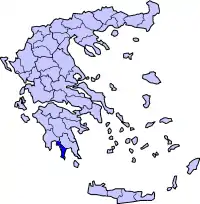Battle of Vromopigada
The Battle of Vromopigada was fought between the Ottoman Turks and the Maniots of Mani in 1770. The location of the battle was in a plain between the two towns of Skoutari and Parasyros. The battle ended in a Greek victory.
| Battle of Vromopigada | |||||||
|---|---|---|---|---|---|---|---|
| Part of Ottoman invasion of Mani (1770) | |||||||
 A map of the Mani. | |||||||
| |||||||
| Belligerents | |||||||
|
|
| ||||||
| Commanders and leaders | |||||||
|
Exarchos Grigorakis Zanetos Grigorakis | Hatzi Osman † | ||||||
| Strength | |||||||
| 7,000 (According to the Greek sources)[1] | 16,000 (According to the Greek sources)[2] | ||||||
| Casualties and losses | |||||||
| Unknown | 10,000 (According to Greek sources)[1] | ||||||
Prelude
Following the Venetian defeat to the Ottoman Empire in the Ottoman–Venetian War (1714–1718), the Peloponnese once again returned to Ottoman hands. However, the autonomous Mani, who had refused to accept Ottoman sovereignty in the first Ottoman occupation of the Peloponnese once again refused to accept Ottoman rule. The Maniots through an agent they had in Russia began conspiring with Catherine the Great and Count Alexei Grigoryevich Orlov. In 1770, terms were agreed and a Russian fleet sailed into the Aegean Sea and landing in Mani en route destroying an Ottoman fleet at the Battle of Chesma.
After initial success, the Orlov Revolt ended in failure. Arguments between Orlov, the Russian leader, and John the Canine, the Maniot leader led to the separation of the armies. John's army suffered a devastating defeat at Rizomilo in Messenia against the Ottoman army with only John surviving. Meanwhile, the Russian army having made no long term gains retreated. The Ottomans had, meanwhile, unleashed mercenaries of Muslim Albanians (also known as Turkoalbanians)[3] on Greece. They pillaged their way through Attica before attacking the Peloponnese where they massacred Greek civilians in revenge for massacres and destruction of properties that Christian forces committed against Muslim civilians.[4]
They launched several incursions into Mani but they were all beaten back with heavy casualties. This string of defeat aggravated the Ottoman Pasha in the Peloponnese, Hatzi Osman and he mustered an army of 16,000 men and invaded Mani. He was held back for twelve days at Kastania but after capturing the towers he advanced down the coast to Skoutari, where he was once again delayed by a tower. This tower was garrisoned by fifteen men who held back the Ottoman army for three days until the tower as undermined and blown up.
%252C_by_Ivan_Aivazovsky_(1848).jpg.webp)
Battle
Meanwhile, a Maniot force consisting of 3,000 men and 2,000 women under the command of Exarchos Grigorakis and his nephew Zanetos Grigorakis had mustered in the hills above the town of Parasyros, which were known as Trikefali, and had fortified themselves. Hatzi, meanwhile, had advanced with his army to Agio Pigada (a plain that lay between Parasyros and Skoutari) and from there sent envoys demanding the surrender of the Maniots. However, the Maniots were hesitant in sending envoys back because if the answer was negative, Hatzi would have the envoys executed.
Three old men, two priests and a layman volunteered and went to the Turkish camp. When they reached the camp, they went to the pasha and without bow they asked him what they wanted from the poor and free Maniots. The pasha demanded that the Maniots give ...ten captains' children as hostages. All your guns and every year a poll tax for your head because you attacked against the Sultan with the Russians, our enemies. The Maniot envoys replied: We prefer to die than give you our guns and freedom. We don't pay taxes because our land is poor. Hatzi, infuriated by their answer, had them decapitated and mutilated before planting their heads on stakes.
When the Maniots saw the fate of their envoys they decided how to defeat the Ottomans. During the night, a force of 1,500 Maniots outflanked the Ottoman positions and approached from the Turkish rear. Meanwhile, the main Maniot force attacked the Ottomans as they slept. The Ottomans, surprised by this night attack started to flee but were cut off by the Maniots at their rear. The remaining Turks managed to retreat to Mystras.
References
- Kassis, "Mani's History", 36
- Kassis, p. 35.
- Nikolaou, Georgios (1997). "Islamisations et Christianisations dans le Peloponnese (1715- 1832)". Didaktorika.gr. Universite des Sciences Humaines - Strasbourg II: 313. doi:10.12681/eadd/8139. hdl:10442/hedi/8139.
Il est à signaler que dans ces contrées s'étaient installés, probablement vers 1715 et après 1770, des Albanais musulmans (Turcalbanais), qui furent l'un des facteurs de diffusion de l'islam.
- Jelavich, Barbara (1983). History of the Balkans. Cambridge. p. 78. ISBN 9780521274593.
The Ottoman government, pressed by the necessity of fighting a major war on its northern boundary, called in Albanian troops, who crushed the expedition at Tripolitza (Tripolis). During the campaign the Christian forces had massacred Muslim civilians and destroyed their property; the Albanians now took a fearful revenge. The damage was so extensive and the troops so out of control that in 1779 the Porte finally had to send a Turkish force to suppress the Albanians.
Sources
- Peter Greenhalgh and Edward Eliopoulos. Deep into Mani: Journey to the southern tip of Greece. London: Trinity Press, 1985. ISBN 0-571-13524-2
- Kyriakos Kassis. Mani's History. Athens: Presoft, 1979.
